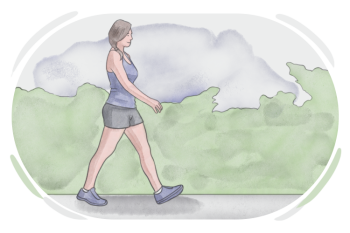Intransitive Verbs

What are Intransitive Verbs?
Intransitive verbs are those that do not need any complements to express a complete meaning. They come on their own to show the action or state of the subject.
Intransitive Verbs: Characteristics
Intransitive verbs have a number of characteristics that distinguish them from transitive verbs and linking verbs.
No Complement
Intransitive verbs do not take any objects or subject complements. They just follow a subject and show its action or state. Take a look at the examples:
I was sleeping.
He coughed.
No Passive
Intransitive verbs cannot be made passive, since the structure of the passive voice requires a verb complement, typically a direct object or object of preposition, to be brought to the subject position, but intransitive verbs do not have any complement that can be shown to receive the action of the verb.
She read the book. → The book was read by her.
A transitive verb can be made passive by moving the object to the subject position.
She slept. → Was slept by her.
Since there is no object, the passive voice is invalid.
What is Not a Verb Complement?
In order to identify intransitive verbs, you should be able to understand words that come after verbs, but are not verb complements. When such words or phrases are used after verbs, the verb remains intransitive as long as no verb complement is present.
Adverbs
Adverbs are adjuncts that can come after verbs to add information about time, place, manner, etc. These are not essential verb complements. They can be removed from the verb without affecting its grammatical structure and do not make a verb transitive. Look at the examples:
He runs quickly.
This is an adverb of manner, it does not constitute a verb complement and the verb remains intransitive.
They arrived late.
This is an adverb of time, it can be removed without affecting the grammaticality of the sentence.


Prepositional Phrases
Prepositional phrases are another common type of adjunct that, like adverbs, can provide extra information without being essential for the grammatical structure of the sentence. Here are some examples:
The plant died in winter.
He was sitting in silence.
Adjunct vs. Subject Complement
While adverbs and prepositional phrases are adjuncts when used with intransitive verbs, linking verbs can use them as subject complements. This usage is different from the intransitive verb because the adverb or prepositional phrase is actually essential for the meaning of the sentence. Compare the examples:
The children were playing in the garden.
Here, "in the garden" is an adjunct since it provides extra information and can be removed from the sentence without affecting its structure or meaning.
The children are in the garden.
In this sentence, "in the garden" is a subject complement since it is indicating the location of the children after the linking verb "be" and removing it would make the sentence incomplete: "The children are."
Overlaps with Transitive Verbs
Some verbs can be both transitive and intransitive, without any difference in meaning. There are two cases where intransitive verbs and transitive verbs overlap.
Ambitransitive verbs
Ambitransitive Verbs
Ambitransitive verbs are verbs that can be both transitive and intransitive without a change in meaning. The difference between the two usages is that the transitive form is more specific as it provides more information.
She is reading.
This sentence is intransitive. It is grammatically correct and expresses a complete meaning.
She is reading a book.
This is a transitive verb, it has a direct object and specifies the thing that is receiving the action of the verb.
He ate quickly.
Remember that here "quickly" is an adjunct, the verb is intransitive.
He ate the cake.
Ergative Verbs
Like ambitransitive verbs, ergative verbs can be both transitive and intransitive without significant difference in meaning. However, they are different from ambitransitive verbs in that the object of their transitive form is the same as the subject of the intransitive form. In other words, the transitive form expresses an active meaning by identifying the doer of the action, while the intransitive form expresses a passive meaning, focusing on the thing that is affected by the action of the verb without attributing the action to an agent. Here are some examples:
He opened the door.
The door opened.
They started the car.
The car started easily.
Tip!
Some verbs take dummy pronouns as their objects. Although this structure is grammatically transitive, its meaning is more closely related to intransitive verbs as the object is not receiving an actual action and is only used as a placeholder.
We'll never make it to the airport on time.
I didn't get it until he explained again.
Review
Intransitive verbs do not take any verbs complements, but they can take adjuncts. Since they do not have a direct object, they cannot be made passive. Additionally, some verbs can be both transitive and intransitive without a difference in meaning.
I read before bed.
This is an intransitive verb with an adjunct of time.
I read short stories.
This is a transitive verbs with the same meaning.
Quiz:
Which sentence contains a pure intransitive verb?
She gave a presentation.
He broke the glass.
The baby slept soundly.
They made a cake.
Which of the following sentences cannot be transformed into a passive voice construction?
The chef cooked a delicious meal.
The teacher explained the lesson.
The audience clapped enthusiastically.
The committee approved the plan.
Fill the blanks based on information from the lesson. (There is one extra option.)
Intransitive verbs do not take any
to express a complete meaning.
Intransitive verbs cannot be made
because they lack an object that could be moved to the subject position.
Adverbs or prepositional phrases that provide additional context after an intransitive verb are called
, not verb complements.
A verb that can be used both with and without a complement without a change in meaning is known as a(n)
verb.
Choose True or False for each statement.
An adverb following an intransitive verb is always a verb complement. | |
Prepositional phrases following intransitive verbs cannot be removed from the sentence. | |
Some verbs can function both transitively and intransitively without a change in meaning. | |
The phrase "in the garden" in "The children played in the garden" is a subject complement. |
Which of the following sentences contains an ambitransitive verb?
She is reading a book.
They are walking down the street.
Jack said he could come
I'm happy for you.
Comments
(0)